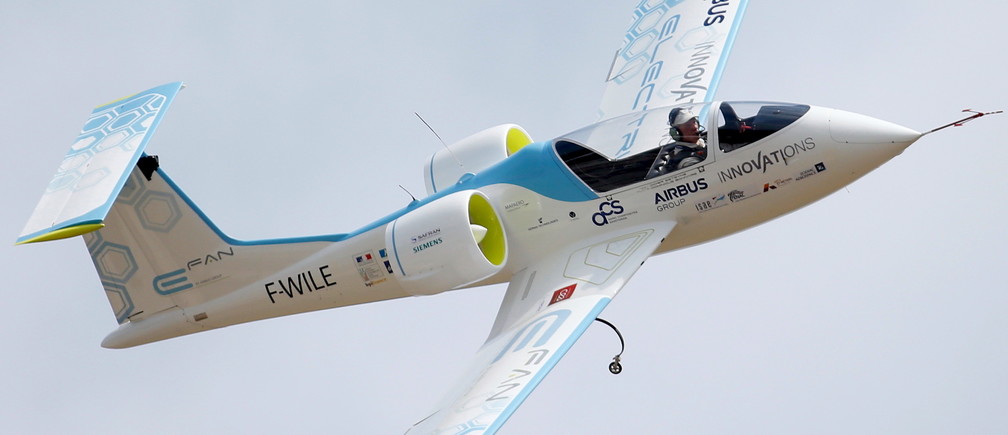The recent announcement from JetBlue Technology Ventures and Boeing that they’re funding Zunum, a startup developing an electric regional plane, has garnered excited reactions from the public and media alike. Everyone is searching for whoever will make the “Tesla of the skies,” a fully electric plane to traverse the world.
But this may not arrive as soon as we’d like and the challenges along the way vary from manufacturers to basic aircraft design.
More Electric Versus Full Electric
So far in the aviation world, the manufacturing focus has been on making airplanes more electric, transferring as many supporting functions to electric power as possible rather than making the entire aircraft fueled by electricity.
Thus in newer aircraft systems like air conditioning, cabin pressure, and de-icing, which typically uses the heated air from the engines, are all powered by electricity. However, more systems can be switched to electric powered to optimize on fuel consumption. One of these options is adding an electric motor for the purpose of taxing.
Currently, airplanes utilize their main engines to drive around and airports runway system, from gate to lift off and back again. For short-haul planes that make frequent flights, up to 10 in a single day, and can spend an average 2.3 hours taxiing, this practice squanders fuel resources. With an electric motor powering the wheels during ground operations, airlines could save around 4% in fuel use.
Another set of functions where electricity could be the main power source is the hydraulic and pneumatic systems that control everything from brakes to landing gear and flight controls.
While these type of changes seem small in comparison to a fully electric vehicle like a Tesla Model S, it is still the next step for aircraft. A combination of these more electric options could make a three percent fuel savings for large passenger jets and help bridge the gap while practical fully electric models are developed.
100% Electric
Once that three percent is taken care of there are only so many systems that can be optimized beyond that. The future in aviation will demand more hybrid and fully electric aircraft options. And such an airplane will need a complete redesign from what we’re used to seeing today.
Recently both Airbus and Boeing have replaced the engines on several of their single-aisle, small airplanes with new 15 percent more efficient ones. However, they are still attached to the wings in the exact same way one would expect. So in neither design nor fuel savings would anyone call the change transformative.
But transformative is exactly what would have to take place in order to achieve a fully electric aircraft. It is not just a matter of replacing the engines, but a number of interconnected factors in design and engineering would have to change. You can’t simply of put a bunch of batteries on the plane and run cords to a bank of newly situated engines the way you might a car. Cars and planes are very different regarding power need and engineering required to operate. Basically, a car doesn’t have to stay in the air the way aircraft must.
To give a clear picture of what a monumental task this is, let’s compare the Tesla Model S, the Airbus E-Fan, and a traditional Boeing 747.
The Airbus E-fan is a fully electric plane that debuted in 2014. It runs on two 60 kilowatt engines and carries two passengers. The Boeing 747, which carries 400-600 passengers, requires 90 megawatts or 90,000 kilowatts for take-off. That’s 1,500 times the power of the E-fan. Further, the battery pack for the Tesla Model S is the equivalent of 2,000 laptop batteries and lies beneath the passenger cabin of the car. On the other hand, the 747 would need the equivalent of 4.4 million laptop batteries.
Obviously, no airplane could carry 4.4 million laptop batteries and more powerful batteries are not answer enough for this problem. The batteries would also need to be smaller and lighter. On top of that, a fully electric 747 would need electric motors capable of producing jet propulsion as well as the technology required to cool them. Add to that the very lightweight materials that can handle extremely high temperatures in addition to integrating these new systems with the energy storage and production onboard and compatibility with the airframe and you can see what a monumental engineering this is aircraft designers.
None of this mentions costs, which, when compared to the relatively low cost of oil these days, becomes prohibitive and does not entice aviation companies to fund the research and development required for such a changeover.
For those truly jonesing for an electric plane ride, don’t be discouraged just yet. While electric jumbo jets that can speedily and comfortably cross the Atlantic may be a far way off, short regional flight electric or hybrid aircraft is just around the corner.
The Airbus E-fan is only one example of the type of crafts that an immense amount of funding has already gone through, including the Lilium, debuting in 2017, and the crafts yet to be from the previously mentioned startup Zunum.
CEO of Airbus, Tom Enders, estimates that there could be electric hybrid planes capable of carrying 100 passengers by 2030. Given a few years for older models to be cycled out and full airline fleets of electric planes could be jetting from New York to Chicago by 2045.
Still, the aviation industry has a history of advancing innovation sooner than anyone expected, and even achieving what was once called impossible, so it’s not much of a stretch to wonder if your next flight might be in the Tesla of the skies and soon than you think.
More News to Read
- What Does it Take to Build the Super Collider?
- According to a New Study, Early Life Stress Can Change Genes in Brain
- Stunning View of Aurora Borealis from ISS in new NASA video
- Imagine Being Able to Explore the Brain Like a Website
- Quantum Computers Made Even More Powerful with New microchip generating ‘Qudits.’











